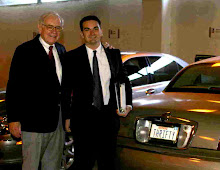Alt Berkshires: Some Choices in Funds
Case # 1 - Weitz Funds
This is the only of the fund companies I will discuss in which I have invested. Wally Weitz and co-manager Brad Hinton run a total of only eight funds. There is an income fund and a money market fund, but the rest of the funds are very similar to each other and essentially aim to mimic a conglomerate like Berkshire Hathaway. And the managers make no secret of the similarities between themselves and Buffett. Weitz lives and operates out of Omaha and projects the down-home, midwestern aw-shucks kind of air. I like that – but I also like his investments.
Not surprisingly, Berkshire Hathaway the number one holding in three of the four marquee funds. Other top holdings include the Washington Post, Wal-Mart and AIG, all of which have clear Buffett ties. Omaha-based TD Ameritrade is held by most of the funds, as is USG – the housing sector-plagued but undervalued bankruptcy play that Berkshire currently owns 18% of. Unfortunately, Countrywide Financial also makes up a good sized chunk of the portfolios. Although Countrywide has been a good investment for the family over the last fifteen years, it will obviously weigh negatively in the near term.
The Weitz Funds family of funds has consistently beaten the S&P 500 over the past twenty years. According to the company, the Value, Partners Value and Partners III funds have earned annual returns of 13.5%, 13.6% and 14.2% respectively versus an S&P gain of 10.7%. The returns have not been as strong recently, including over the time I have owned the funds (about four years). Two of the three funds mentioned above lag the market over the past five years.
The fees are exceptionally reasonable, as one might expect for an alt-Berkshire. There is no load, of course, and the funds charge between 1.1% and 1.3% of assets per year.
Case #2 – Tilson Mutual Funds
Probably better known than Weitz Funds, but only because Whitney Tilson is a well known author in addition to fund manager. He co-authored Poor Charlie’s Almanack, the best book available about Charlie Munger and writes for several national periodicals.
The company is brand new and has a short track record, but what it has is very impressive. Mr. Tilson formed the company in 2005 after developing a reputation as an astute value investor in private equity and has beaten the market handily since. In fact, during this past year’s bull market the flagship Focus Fund has nearly doubled the already steep growth of the market. But because it is still young and unproven, it is probably better to focus on the funds’ philosophy than their performance.
Mr. Tilson has only two funds – the Tilson Focus Fund and an income fund known as the Tilson Dividend Fund. Berkshire Hathaway represents a remarkable 14% of the Focus Fund. When they say “focus" they mean it. It has some overlapping holdings too, including USG. The annual report features a section outlining the company’s investment philosophy that might as well just quote Berkshire’s Owners Manual; eating their own cooking, demanding a margin of safety, and holding cash in the absence of good opportunities. These are principles a value investor should look for. It also demonstrates an emphasis on long-term performance, even though the funds’ performance in the short term has been stellar.
Tilson Fund’s fee structure is a little disappointing, though. In addition to a 2% back-end load the Focus Fund also charges more than 2.4% per year.
There are some other alt-Berkshires that aren’t available to the average joe, but are probably worth mention nonetheless.
Sequoia Fund
Bill Ruane, a former classmate of Buffett’s and Graham disciple, formed this company in 1970. In fact, when the original Buffett Partnership was dissolved, Buffett referred his clients to Ruane. The success of the fund is undeniable, but since 1982 has been closed to new investors. This has made its growth far less constrained and thus much more impressive than, say, Fidelity Magellan, which got so big it simply couldn’t get much bigger.
Pabrai Funds
Mohnish Pabrai seems to have come out of nowhere to become one of the more prominent value investors today. Perhaps it was the highly acclaimed book he released earlier this year, The Dhandho Investor, or more recently his winning bid of $650,100 to have lunch with Warren Buffett. Whatever it is, this guy seems like someone worth following. But Pabrai does not sell mutual funds, so the small investor probably won’t be able to share in his investment success. That doesn’t mean one shouldn’t follow Mr. Pabrai, though, who appears to have a strong interest in sharing his knowledge, in much the same way Mr. Buffett does.
FD: Long Weitz Value, Weitz Hickory, Berkshire Hathaway, USG. No position in any other security mentioned.


1 Comments:
I just read your post on FeedTheBull. It was a great read. Keep up the blogging.
By FeedTheBull, at 06 August, 2007 08:40
FeedTheBull, at 06 August, 2007 08:40
Post a Comment
<< Home